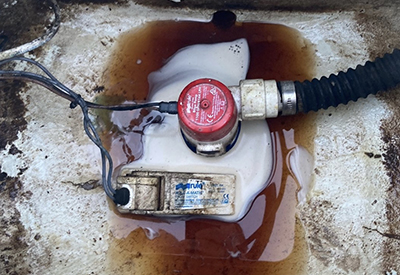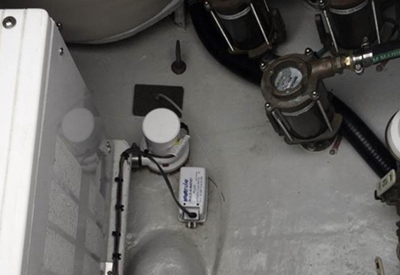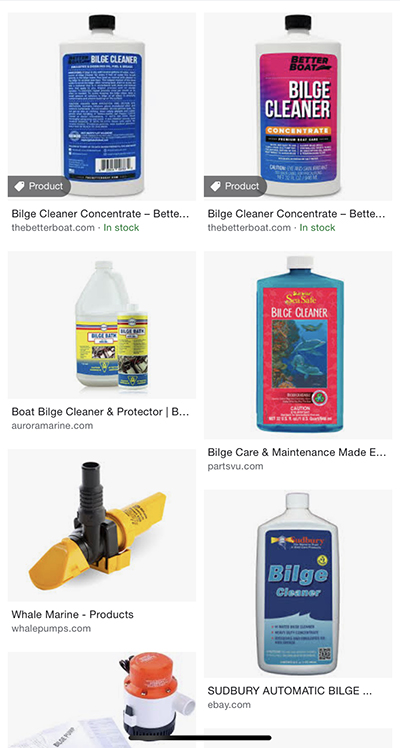Ask Andrew: Cleaning the Bilge – ugh

Nov 25, 2021
Before
Years ago it was a punishment. In the Royal Navy, and on merchant ships of the 19th century, the gun crews who were the quickest would receive an extra tot of rum. The crew who were slow or sloppy were tasked with cleaning out the ship’s bilge.
Luckily, most of us aren’t press-ganged into cleaning the bilges. That doesn’t make the job any better, however.
So why do we bother? There are a few reasons:
The smell. Sitting, dirty water has a particular odour. In my house we simply describe it as ‘that boat smell’. A clean bilge, makes being aboard (and near or under the floor boards) that much more enjoyable.
The wear and tear. The marine environment is tough enough. But add in stagnant water, oil, dirt, contaminants, mould and mildew. Now consider the slow damage that might be caused to wiring, terminal connections, hoses, hose clamps, wood, metal hardware, seacocks, caulking and sealants.
Function. A boat floats and moves in its most ideal way when the bilges are empty. That said, the bilge exists for a reason: boats are designed to have water flow in and out. Water comes in via the stuffing box, through-hulls, livewells, water over the gunwhales, and rain. Water is then pumped out using the bilge pumps. If the water in the bilges isn’t free of contaminants and debris, it can cause the bilge pumps to stop working. Similarly, contaminated water can pose environmental concerns if that contaminated water is pumped overboard. In short: your boat will function better, will be more enjoyable to be aboard, and will require less maintenance and repairs over the long term, if the bilges are kept clean in the short-term.
 After
After
What’s the best way to go about it?
First: remove the bulk of water and debris. If the water is not contaminated, the level can be lowered by operating the bilge pumps (either electric or manual). This can be followed by using a wet/dry shop vac, or even through the use of sponges and a bucket. If the water is contaminated, it should be treated (and disposed of) as you would used oil. Any/all debris should be removed by hand or vacuum. Wire ends, broken zip ties and small pieces of plastic have a way of making themselves into the bilge pumps and causing the vanes to stick and stop working.
 a quick google search reveals many dozens of bilge cleaning products
a quick google search reveals many dozens of bilge cleaning products
Next comes the cleaning. There are many products available and sold specifically as bilge cleaners. The common denominator is a degreasing element, and a deodorizer: The cleaner should act to remove oils, grease, mould, mildew – and smell nice in the process. I typically use Dawn dish soap and a scotch-brite pad. The dish soap works well as a degreaser and isn’t harmful when pumped overboard (unlike other, more powerful cleaners).
I start by turning off the bilge pumps (I take it a step further by disconnecting the batteries completely so that any wiring in the bilge spaces are no longer hazardous). I then add cleaner and a light amount of water to the entire bilge areas. Caked on contaminants may require that the cleaner sits to allow it to activate and break down the sludge. Other areas can be scrubbed a few minutes after contact.
Rinse and repeat. Fresh water will need to be added to remove any accumulated debris and sludge, and may also need to be drained or sifted through to remove the solid and gelatinous portions. Dispose of the water accordingly, and add more cleansers and water (and elbow grease) as needed.
Reconnect any hoses, open any seacocks, re-activate (and test) bilge pumps.
Finally: Try to minimize full bilges in the future. Repairs the sources of any leaks of antifreeze, fuel, oil, grease and debris. If some of these contaminants are inevitable, lay down bilge socks or pads to allow them to be soaked up and separated from any surrounding water in the bilge. Eliminate as many sources of water as possible: tighten stuffing boxes, repair leaks and ensure that hoses are in good condition. Now is a great time to check the bilge pumps and ensure that they are in the optimal location, and that floats are working correctly.
While the bilge is clean, it may also be time to replace damaged hose clamps and hoses, clean hose surfaces, and clean the underside of the cabin sole. As a parting thought: ventilation goes a long way in some of the enclosed spaces on a boat. Adding vents, tools to move air through the boat, and dehumidifying products can add the final touches to this once daunting project.
 Andrew McDonald is the owner of Lakeside Marine Services – a boat repair/maintenance firm based in Toronto. Andrew has worked in the marine industry for 12 years and is a graduate of the Georgian College ‘Mechanical Techniques – Marine Engine Mechanic’ program.
Andrew McDonald is the owner of Lakeside Marine Services – a boat repair/maintenance firm based in Toronto. Andrew has worked in the marine industry for 12 years and is a graduate of the Georgian College ‘Mechanical Techniques – Marine Engine Mechanic’ program.
Questions or comments for Andrew? Email him directly via: askandrew@lakesidemarineservices.ca




























